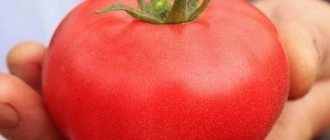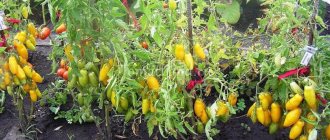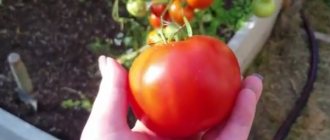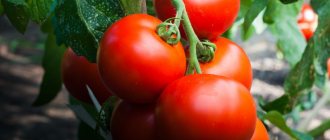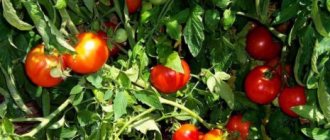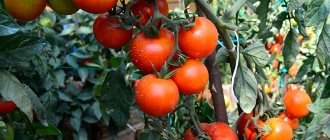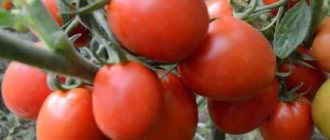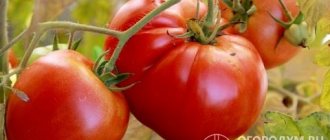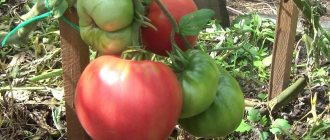Kuban has historically been a supplier of tomatoes to the market of all regions of Russia. This region includes the Krasnodar and Stavropol Territories, the Rostov Region, the Republics of Adygea and Karachay-Cherkessia. The "Kuban" variety was grown on this fertile land. He is loved in many regions of our vast Motherland. One fruit weighs on average 70-100 grams. The yield per 1 m2 is from 6.5 kg.
In this article we will talk about tomatoes of the “Kuban” variety. This is a mid-season variety, the harvest of which can be harvested within 3 months after the appearance of the first shoots. The fruits are oval, oblong, smooth to the touch, bright red in color.
Description of the variety
By the name of the variety it is easy to guess its origin.
The Krasnodar tomato was bred for hot climates with frequent dry periods. However, tomatoes can often be found in the middle zone - already in greenhouses. Main characteristics:
- spreading bushes with powerful roots;
- greenhouse tomatoes reach 2.5 m, street tomatoes stop at 1.9 m;
- foliage is above average, leaves are light green;
- cluster fruiting, 3-5 tomatoes per ovary;
- It is better to lead in 1 stem, but 2 are allowed.
The Krasnodar tomato is suitable for use in fresh dishes; it can be pickled and juiced.
According to ripening time | By type of growth | By type of use | By growing method | Fruit weight (g) | Productivity (kg/m2) | Fetal characteristics |
| Mid-ripe, 95-110 days | Indeterminant, 190-250 cm | Universal | For open ground or greenhouses | 400-700 | In the garden from 18, in the greenhouse from 25 | Pinkish-crimson, flat-round, with obvious ribbing at the base. |
Agricultural technology
As you know, tomatoes can be grown:
- using seedlings;
- using the seedless method.
Both have an economic rationale. An arid climate requires the presence of seedlings and greenhouse conditions. Soft seaweed is native to tomato crops; here you can get by by sowing seeds in open beds.
The soil should be light and nutritious. A mixture of humus, sand and earth is ideal. Usually the soil is prepared in late autumn, spreading humus throughout the area. During the winter and part of spring it rests, some of the nutrients are absorbed into the soil with the help of melt water. After this, complex fertilizers are added and dug up. All that remains is to choose the right time to plant seedlings, care for them and wait for the harvest.
Complex fertilizers are usually used - the risk of overfeeding the plant with a single element is reduced. Sometimes there is a need for spot feeding of tomato varieties for the Krasnodar Territory - open ground allows the application of fertilizers using liquid or dry methods.
For these purposes they usually use:
- superphosphate (phosphorus content 20%) or double superphosphate (45%);
- potassium nitrate;
- urea
To plant bushes in such soil, it is pre-treated with all three types of fertilizers. The recommended ratio is 1:1:1. After the first fruits appear, the proportion is changed - 3:9:1.
The proportional composition of the fundamental elements in Krasnodar and the region is selected individually by region. The soil is different everywhere; after harvesting, its composition changes greatly. The increase in the amount of potassium and phosphorus during fruit formation is due to the increased need of the crop for these elements. Fertilizer application schedules can be considered as zoned - their composition varies over the entire area of the region.
Foliage is a kind of indicator of increased concentration of elements:
- magnesium, phosphorus - leads to blackening of leaves along the edges;
- nitrogen - yellowing;
- potassium - development of necrosis;
- calcium is a growth stimulator; the crop cannot cope with such a load and dies from a lack of other elements.
Every gardener before the start of the season wonders when to plant tomatoes. The usual period is 40 – 45 days before the start of disembarkation. When growing, they strive to create a plant that meets certain requirements:
- color - rich dark green;
- strong elastic leg;
- the number of fully formed leaves is 5 – 6;
- height - at least 20 - 30 cm;
- appearance is fresh.
You can use a planting calendar and decide when to plant tomato seedlings. It is also called lunar. It is believed that seedlings grow better when the moon is rising. Why is this happening? Perhaps the plant receives more moonlight or is exposed to gravitational fields.
Experienced gardeners plan in advance the time to plant tomatoes and study the weather forecast.
The main risks associated with its growth:
- You can get overgrown seedlings. In this case, it becomes unsuitable for planting. Before sowing tomatoes for seedlings, you need to plan fertilizing. When there is an overdose of beneficial elements, the sprouts grow too quickly. The stem turns out thin, unable to hold foliage and ovaries.
- Lack of lighting can cause the plant to grow rapidly. Usually in Kuban when the season begins, the weather is sunny. When growing at home, nuances are possible. To prevent this from happening, it is recommended to use artificial lighting. This is done using specially installed LED lamps in red, green, and blue colors. It is necessary that the light washes the plant - in this case, a thick stem and elastic foliage are formed.
- Usually they take a supply of three to ten days from the moment when the seeds are sown. This is done to check germination - low-quality seeds take a long time to produce the first shoots. Healthy, strong seeds produce the first shoots already on the third day after planting.
To check germination, your favorite or best tomato varieties must first be checked. Seed material is poured into warm water and waited for at least 10 minutes.
Description of the variety
This variety has long been established throughout the country, so every summer resident plants it if possible. The Krasnodar tomato is also called a giant because its fruits grow quite large. This variety is excellent for growing both in greenhouse conditions and in open ground.
By the way, the name “giant” fully justifies the weight of ripe tomato fruits. On average, they reach 500 g and even 700 g. But this parameter directly depends on the weather conditions in which the vegetable was grown, as well as on how carefully and carefully it was monitored. Krasnodar tomatoes are also famous for the fact that they have a specific shade. They are not bright red in color, but pinkish-crimson. According to experts, tomatoes growing with pink skin are more beneficial for the human body than any other.
This opinion was drawn up on the basis of studies of the structure of the vegetable. It contains many vitamins, as well as fiber, various antioxidants and carotene. If we focus on taste, it is worth noting that tomatoes of this variety are often sweetish and have a light and unobtrusive sour taste. This combination is very specific, so some gardeners even undertake to grow this vegetable for the purpose of subsequent resale.
Note! If you decide to subsequently sell your tomatoes, keep in mind that they require especially careful care. The fact is that pinkish tomatoes are much more expensive than standard red ones. This variety is also a leader in terms of fruit size.
Therefore, in order to get the highest possible revenue, pay attention to the condition of the tomatoes and constantly monitor them.
Features of growing and caring for the variety
Krasnodar tomatoes are known throughout Russia due to their unique properties. Many varieties have become favorites not only for large-scale commercial purposes, but also for growing in small summer cottages.
Vegetable growers have noticed that there is simply no significant difference between tomatoes grown through seedlings and without seedlings. Seeds sown immediately into the ground germinate later, but then the seedlings catch up with it. Seedlings, but night temperature fluctuations are not dangerous. Such tomatoes are less susceptible to diseases.
“Kuban” tomatoes are recommended for planting in open ground, and care rules must meet certain requirements:
- Watering the plant must be done in the morning or evening.
- You need to pour water at the root of the plant, otherwise the foliage may burn.
- We must not forget about feeding the crop with nutrients. Fertilizers must be applied several times per season.
- Tomato seedlings most of all need phosphorus, nitrogen (ammonium chloride) and potassium (you can take ash). With a lack of these substances, the plant becomes weak with poorly developed foliage.
- Although tomatoes of the “Kuban” variety are resistant to various types of diseases, do not forget about taking preventive measures.
Seedling
Every gardener before the start of the season wonders when to plant tomatoes. The usual period is 40 – 45 days before the start of disembarkation. When growing, they strive to create a plant that meets certain requirements:
- color - rich dark green;
- strong elastic leg;
- the number of fully formed leaves is 5 – 6;
- height - at least 20 - 30 cm;
- appearance is fresh.
You can use a planting calendar and decide when to plant tomato seedlings. It is also called lunar. It is believed that seedlings grow better when the moon is rising. Why is this happening? Perhaps the plant receives more moonlight or is exposed to gravitational fields.
Experienced gardeners plan in advance the time to plant tomatoes and study the weather forecast.
The main risks associated with its growth:
- You can get overgrown seedlings. In this case, it becomes unsuitable for planting. Before sowing tomatoes for seedlings, you need to plan fertilizing. When there is an overdose of beneficial elements, the sprouts grow too quickly. The stem turns out thin, unable to hold foliage and ovaries.
- Lack of lighting can cause the plant to grow rapidly. Usually in Kuban when the season begins, the weather is sunny. When growing at home, nuances are possible. To prevent this from happening, it is recommended to use artificial lighting. This is done using specially installed LED lamps in red, green, and blue colors. It is necessary that the light washes the plant - in this case, a thick stem and elastic foliage are formed.
- Usually they take a supply of three to ten days from the moment when the seeds are sown. This is done to check germination - low-quality seeds take a long time to produce the first shoots. Healthy, strong seeds produce the first shoots already on the third day after planting.
Tomato seedlings will give a good harvest in the future only if they are grown according to all the rules. Tomato seedlings will give a good harvest in the future only if they are grown according to all the rules. If you know the intricacies of this process, then achieving the desired result will not be difficult.
Variety selection
Tomato seedlings should feel good in your area. Everyone knows that conditions in the North and South are different
This needs to be taken into account
Southern varieties, on the contrary, are distinguished by powerful foliage that protects the plant from the scorching sun. Development is slow, resistance to external influences is high.
So, depending on the region, tomato seedlings of the following varieties should be planted.
For the northern and central regions, tomato seedlings of the “Alaska” variety should be planted
For the northern and central regions:
- Yamal;
- Alaska;
- Taimyr;
- White filling;
- Snow fairy tale and others.
For the central black earth region:
- Solar;
- Maryushka;
- Peremoga;
- Olya and others.
For southern regions:
- Torch;
- Agatha;
- Titanium;
- Veneta;
- Newbie.
To obtain good tomato seedlings in a greenhouse, you should select the seeds correctly. The selection criteria are as follows:
- the seeds must have good germination;
- be pure, without unnecessary impurities.
It is necessary to take not all, but the most viable seeds. We'll have to go through everything. Those with atypical colors, weak and injured should be removed.
For the southern regions, tomato seedlings of the “Titan” variety should be planted
Calibration can be done by weight. The seeds are placed in a solution of table salt (3%). Then they are thoroughly mixed. Healthy ones will sink to the bottom. They should be selected and dried thoroughly.
Before planting in open ground, the seeds are treated. First of all, disinfection is necessary to avoid the occurrence of infections. To do this, a whole range of actions is carried out:
- The seeds are dipped in a solution of potassium permanganate for 20 minutes. They are then washed in water.
- The seeds are kept in a solution of garlic pulp for an hour, while the jar must be closed. They are then washed and dried.
- You can try soaking for 2 hours in a 0.2% solution of phytoflavin.
Features of growing tomatoes in the Krasnodar region
Summer there is very hot. The summer resident must remember this when choosing species. It is better to choose tomatoes that are resistant to high temperatures and strong sun. For planting, zoned species are used. It is advisable to choose varieties that have wide leaves; vegetables grow under the cover of powerful green mass.
The Krasnodar region is very large; the Kuban River divides it. Each part differs from the other in climatic features. The northern part is characterized by an arid climate. And in the mountainous southern part there is often precipitation, so the climate is more humid, similar to the Stavropol Territory.
In the southern part, tomatoes are planted directly in open ground, and in the north they are grown using only seedlings.
The best varieties of tomatoes for the South of Russia in open ground
Which tomato is best suited for open ground? It is impossible to give a definite answer to this question. After all, each category and each region of Russia has its own favorites.
In open ground you can grow the entire range of tomatoes: determinate and early ripening, popular ultra-early and super-early, from low to high. They also differ in taste, color, aroma, chemical composition and juiciness. Owners of even the smallest plots of land try to plant at least a few tomatoes on them.
Banana yellow
Very tall three-meter bushes bear fruit in an average period of 125 days. The clusters contain up to 10 yellow tomatoes up to 7 cm long. The shape of the fruit is elongated, with a slightly curved “nose”. Tomato weight – 120 g. Fleshy, sweet, dense tomatoes of universal use, capable of staying on the stalk for a long time after full ripening.
Advice! As soon as the ovaries have formed on all the hands, the top of the tomato bush is pinched.
Bison (orange, yellow, black)
Large tomatoes ripen late on a tall bush, which requires support and garter. The weight of some fruits reaches 900 g. The tomatoes are round in shape, flattened at the poles, with weak ribbing.
Winner
The variety is early ripening. Bushes up to 0.7 meters. Red tomatoes are elongated, with ribs, each fruit weighs 120 g. The best cold-resistant variety allows you to grow tomatoes in the south without seedlings, directly into the ground.
Volgograd early ripening
Harvesting is possible after 100 days. The low bush forms clusters of 5 to 9 tomatoes, 90 g each. The red fruits are smooth, slightly ribbed. The variety is undemanding to care.
Pink giant
A variety with bushes of huge sizes up to 5 m, produces giant fruits of about 1 kg after 120 days from the first shoots. Bright pink, flat-round tomatoes have sugary, fleshy and juicy pulp. The best yield indicators, up to 10 kg per bush.
Mikado
Large-fruited mid-early variety. Pink-raspberry fleshy tomatoes weighing 400 g, do not crack. Tall bushes are productive in all weather conditions. Productivity 3.5 kg per plant.
Gift
Compact plants no more than 80 cm with an average ripening time of 112 days. Round red tomatoes up to 150 g. Heat-resistant tomato. Productivity 3.5 kg per bush.
Titanium
A determinate bush no higher than 70 cm is ready to bear fruit after 125 days. Scarlet tomatoes are round and dense, 150 g each. Exquisite aroma and taste. Productivity 4.5 kg per plant. The seeds are genetically endowed with high immunity.
Ermak
Variety for late harvest 140 days. Compact bushes up to 50 cm in height. Oval red-orange tomatoes, 65 g each, store well. Maturation is friendly. Productivity is high.
Below are the best hybrids that are actively grown on farms in the Rostov region.
Scarlet caravel F1
The seeds of the best new raceme variety quickly gained recognition among vegetable growers. Tall tomato bushes are suitable for greenhouse cultivation. The harvest is obtained in 110 days. Many clusters of 10 fruits each. Slightly elongated red tomatoes, about 130 g, dense, do not crack, do not fall off. The seeds have a gene for resistance to temperature changes.
Elf F1
Harvesting of the cherry variety begins after 95 days. Tall bushes produce clusters of 16 fruits. Dark red spherical tomatoes, no more than 20 g, with sweet, dense pulp. The seeds impart resistance to fungal infections to the plant. Long shelf life of crops in clusters. Possibility of growing in hydroponic conditions.
Sweet fountain F1
I harvest the cluster harvest after 100 days from the first shoots. Indeterminate bushes have high yields. Red oval tomatoes weighing 20 g each with high tasting qualities and dessert taste. The fruits are collected in 20-30 tomatoes. The seeds produce disease-resistant plants; tomatoes do not crack or fall off.
Golden Flow F1
Mid-early Rostov cluster hybrid with high yield. Indeterminate bushes with bright yellow round tomatoes, 50 g each. Fruits are collected in 10-11 pieces. The hybrid tolerates temperature changes and does not succumb to diseases.
Attention! There is a variety of Kharkov breeders with a similar name. Determinate bushes produce oval dark yellow tomatoes 80 g
Magic Harp F1
It takes less than 100 days for the first harvest to ripen. The indeterminate hybrid is grown from seeds in greenhouses and bears fruit during hydroponic cultivation. Compact clusters are formed of 15 fruits each. Round tomatoes of yellow-orange color, about 21 g, with dense, sweet pulp. Tomatoes do not fall off or crack. The best hybrid with high immunity. Fruits under unfavorable conditions.
Advantages and disadvantages, as gardeners say
Advantages:
- The tomato bears fruit abundantly, the taste of the fruit is sweet with a subtle sourness.
- The harvest is easy, the fruits are strong.
- Care is simple, even a novice vegetable grower can handle it.
- Tomatoes are rich in vitamins and amino acids and are recommended for children.
- Lots of chambers with seeds.
- Resistance to pests and the most common diseases of nightshade crops.
- The juicy pulp is covered with a thin but strong peel. Damage during transportation is extremely rare.
- Storing tomatoes does not harm the quality of the product.
Flaws:
- Garter required.
- The downside of large fruits is that it is impossible to use whole fruits in preparations.
Reviews:
You can use it for canning, but it would be better to use juices or lecho. Salads with this tomato do not require a strong dressing, a lot of juice. The taste is unusual. Easy to care for, can be planted by beginning gardeners. In an open garden bed we got 8 kg from a bush with 1 stem (Evgeniy, Rostov region). Growing seedlings is half the success
It is important not to overfeed and plant on time. They ripen evenly, never less than 400 (Anna, g
Voronezh).
Which tomato varieties are the most productive for open ground?
In this section we will tell you about the best varieties of tomatoes. All of them have been grown for many years by experienced summer residents and are considered the best in terms of yield and quality of fruit.
"Gribovsky"
This variety is very popular among gardeners; it has early ripening periods and is a compact bush. These tomatoes not only produce very good yields, but are also resistant to cold and disease. The weight of one fruit reaches 100 grams. Their color is bright, scarlet.
"Alpatieva 905a"
It has an average ripening period and a small bush height. Tomatoes have a red skin color and compact size, which makes them very good for canning. It can be stored for a long time, which makes it possible to sell and transport it. Often used for salads. Another advantage of the variety is its high resistance to disease.
"Present"
More often grown in regions with warmer climates. But at the same time the harvest is good even in a temperate climate. The variety has an average ripening period, does not require special labor costs, and is unpretentious. The fruits gain weight 110-120 grams. They have a slightly flat and round shape, and the skin color is red. Can be grown even without seedlings.
"Waterfall"
Belongs to the early species, has a tall bush. Requires difficult care, as it can hurt. The fruits are small in size and coarse in shape. A good variety for canning without cutting tomatoes. Also refers to productive tomato varieties.
"Kuban standard 220"
The variety ripens late and is very tasty. Tomatoes are used to prepare various dishes; they are especially often used to make pasta. The tomatoes of this variety are large, sweetish, fleshy, and have a red-orange color.
"Roma"
The bushes of small height produce very good fruits. Tomatoes are used both for canning and for fresh eating. The yield of each bush is high, uniform, and the shape of the fruit is unusual. It also does not require special care and tolerates periods of illness well. According to experts, these tomatoes are among the best varieties of tomatoes for open ground. That's why he's so in demand.
"Anastasia"
A hybrid variety, very popular among summer residents. Produces large, juicy tomatoes weighing more than 200 grams. Unpretentious, disease resistant, very tasty. The color of tomatoes is red.
"Crimson Giant"
If you answer the question: the best varieties of tomatoes, then you can’t help but. Its name speaks for itself, since the variety produces very large, crimson-colored fruits weighing up to 700 grams. One brush on a bush can produce 6 fruits, while the species is unpretentious and resistant to disease.
"Search F1"
A hybrid variety that is often grown by experienced gardeners. The fact is that it is always strewn with delicious fruits. Used for fresh food, for heat treatment, and for preservation. Immune to disease and cold.
"Ilyich F1"
Like the previous variety, it is a hybrid variety and is valued by our summer residents for its good fruits. Can be used for any dishes. It is also worth noting that, like the “Search” variety, it can be grown not only in open ground, but also in greenhouses. These two types of tomatoes are very similar to each other in terms of agricultural technology.
Storage rules
Tomatoes of the Kuban variety have proven themselves very well in long-term storage. At the same time, they do not lose their taste. It is necessary to follow several rules for collecting and sorting fruits:
- You need to harvest the crop only in dry weather, and carefully - in a basket with thick burlap lined inside. The fruit must be removed with the stalk.
- We carefully select vegetables. Tomatoes for storage should be green or milky in color. It is necessary to select very carefully, discard fruits even with minor damage and visual signs of disease and pests. Vegetables must be clean, healthy, and of the correct shape.
- The room for storing tomatoes must be well ventilated with a relative humidity of no more than 85%. The temperature in the warehouse should not be higher than 12°C.
There are several ways to store Kuban tomatoes:
- Fruits selected by size, color, shape and quality are placed in clean, Bulgarian-type lattice boxes, pre-treated with a disinfectant solution, with clean paper lined inside.
- The tomatoes are laid out in rows with paper or the fruits themselves are wrapped in it, then sprinkled with a thin layer of peat or sawdust. Next, you need to constantly monitor the condition of the tomatoes, sorting them out, and ventilate the room.
- In order for the tomatoes to ripen, they are taken out to a room with a room temperature of 20-25°C and good ventilation. Ripening takes a week or a little more and depends on warmth and the presence of natural light.
- Unripe tomatoes can be stored for up to three months, and this also depends on the room where they are stored, as well as on the quality of the selected fruits.
- Tomatoes collected in late autumn at the stage of milk ripeness and carefully sorted are wrapped in black tissue paper and packed in a box with bars, having previously been disinfected. Dry, clean straw material is placed inside and taken into a dark room. There they lie at 8-10°C and with sufficient ventilation.
In such conditions, tomatoes can be preserved until the beginning of winter. As necessary, they are sorted for ripening to a rich red color, which proceeds in the same way as in the first method. For better preservation, you should sprinkle the tomatoes with sawdust or dry peat. Next, the tomatoes are checked every 5 days.
Tomato varieties for greenhouses in the Krasnodar region
It is much easier to grow Krasnodar tomatoes in a greenhouse, so there are varieties for greenhouse cultivation. Let's look at what varieties exist for growing tomatoes in a greenhouse in Kuban:
Tomato Pudovik: characteristics and description of the variety
Unlike those previously discussed, this is a variety of large tomatoes. They are meaty and many consider this Kuban tomato to be the best of the heavyweight representatives of the crop. Bushes are much more powerful and require support, otherwise they may break. Ripening time is average. Fruit weight - up to 1.2 kg. Shape: elongated heart-shaped. In open ground, the height of the bush is up to 120 cm, in a greenhouse - up to 180 cm.
Grade No. 4
Pros:
- Large fetal weight;
- High yield - up to 20 kg per m², provided that no more than 4 bushes are planted in this area;
- Ideal for preparations: juice, lecho, tomato ketchup;
- Very tasty in salads;
Minuses:
- Requires constant care and fertilization;
- Susceptible to certain diseases;
- Support structures are needed;
- Shows its best qualities in humid climates.
Tomato Zhirdyai F1: characteristics and description of the variety
A greenhouse or open ground is its habitat. Moreover, in the first case, the yield from one bush is much higher. This is also a hybrid. The fruits are large - over 300 g. At the same time, the bushes are not very large - no more than 80 cm. The ripening period is average. The first ripe tomatoes will appear 110 days after the seeds germinate. The shape is a ball. Clumps of tomatoes are forming on the bush.
Grade No. 5
Pros:
- Large fruit weight;
- Great taste;
- High resistance to diseases;
- Good yield for greenhouses - up to 9 kg. per m²;
- Used both fresh and canned.
Minuses:
- Seeds are not formed for the next year;
- Supporting structures are needed, including for brushes with tomatoes;
- Requires constant care and fertilization;
- They love insects.
Note! It is necessary to remove large tomato fruits as they ripen, because... branches may break off under heavy weight
Even if the tomato is a little green, it’s okay - it will ripen at home.
Tomato Krasnodar: characteristics and description of the variety
The main habitat is a greenhouse. Refers to the early varieties of tomatoes for Kuban. Ripening time is about 3 months. The bushes are small - up to 60 cm. Fruit weight - up to 110 g. The shape is elongated, plum-shaped. This variety is unpretentious and well suited for mechanized harvesting. Because The fruits are medium-sized, ideal for whole canning.
Grade No. 6
Pros:
- High yield - from 6.5 kg per m², taking into account the low weight of the fruit;
- High resistance to diseases;
- Unpretentiousness;
- Due to their shape, the fruits are ideal for industrial harvesting.
- Extremely tasty and aromatic.
There are no downsides to this variety of tomatoes.
Reviews
Olga, 43 years old, Krasnodar:
“Every year we plant “Kuban” - this variety is low-growing, very productive and has never suffered from late blight, black leg or blossom end rot. Guests came and praised the tomatoes for their aroma and taste.”
Ekaterina, 37 years old, Volgograd:
“Today I received Kuban tomato seeds. I will try. My mother-in-law advised. Her harvest from this variety was simply overwhelming, and everyone came together in unison, at the same time. Fruit shape: cream with pimple, deep red color, unforgettable sweet taste. The pulp is not watery. My mother-in-law treated me to adjika, sauce, and pickled Kuban tomatoes. They ate fresh until October. They keep well. I recommend to all."
Galina, 59 years old, Rostov-on-Don:
“I am not an experienced gardener. But because of the good reviews, I decided to try Kuban. The tomatoes grew until late autumn, without shelter. Very good variety. The tomatoes are sweet and juicy."
source
Vegetable growers living in this area are faced with the problem that the type of tomatoes does not correspond to the climatic characteristics of the region. The choice of the best variety of tomatoes for the Krasnodar Territory remains with the summer resident. There are many species that thrive in this climate.
- 1 Features of growing tomatoes in the Krasnodar region
- 2 The best varieties for the Krasnodar region 2.1 Early cycle tomato varieties
- 2.2 Medium and late ripening cycle tomato varieties
- 2.3 Universal varieties
- 2.4 Hybrid tomato varieties
- 4.1 Heat-resistant varieties
- 5.1 For open ground
